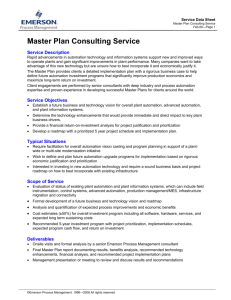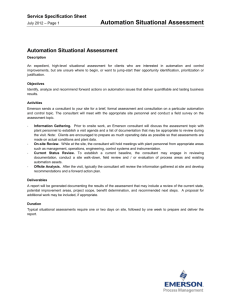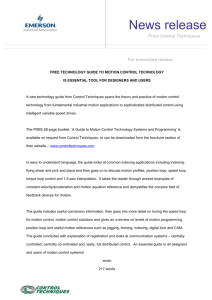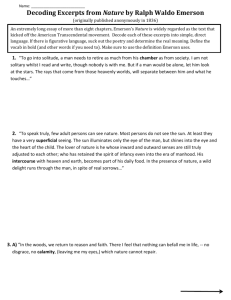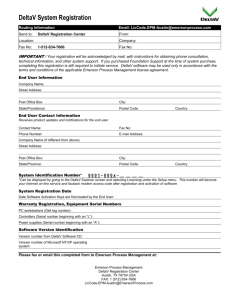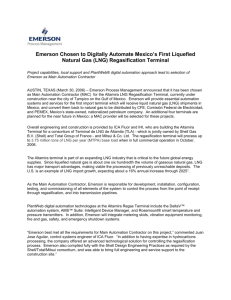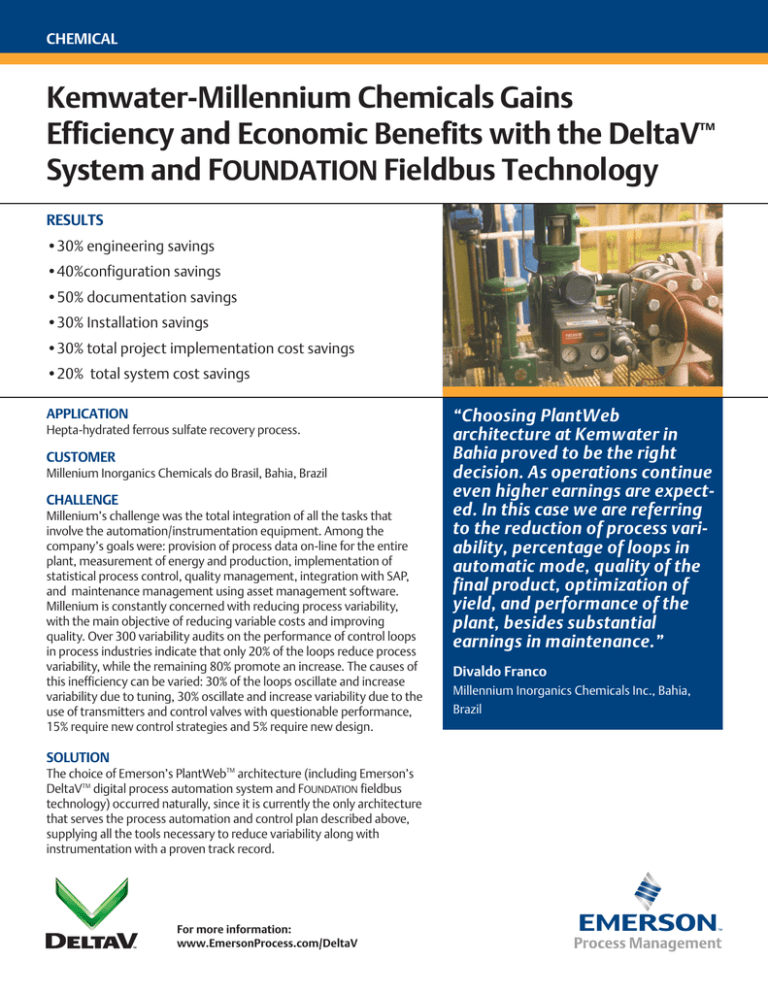
CHEMICAL
Kemwater-Millennium Chemicals Gains
Efficiency and Economic Benefits with the DeltaV™
System and FOUNDATION Fieldbus Technology
RESULTS
•30% engineering savings
•40%configuration savings
•50% documentation savings
•30% Installation savings
•30% total project implementation cost savings
•20% total system cost savings
APPLICATION
Hepta-hydrated ferrous sulfate recovery process.
CUSTOMER
Millenium Inorganics Chemicals do Brasil, Bahia, Brazil
CHALLENGE
Millenium’s challenge was the total integration of all the tasks that
involve the automation/instrumentation equipment. Among the
company’s goals were: provision of process data on-line for the entire
plant, measurement of energy and production, implementation of
statistical process control, quality management, integration with SAP,
and maintenance management using asset management software.
Millenium is constantly concerned with reducing process variability,
with the main objective of reducing variable costs and improving
quality. Over 300 variability audits on the performance of control loops
in process industries indicate that only 20% of the loops reduce process
variability, while the remaining 80% promote an increase. The causes of
this inefficiency can be varied: 30% of the loops oscillate and increase
variability due to tuning, 30% oscillate and increase variability due to the
use of transmitters and control valves with questionable performance,
15% require new control strategies and 5% require new design.
SOLUTION
The choice of Emerson’s PlantWebTM architecture (including Emerson’s
DeltaVTM digital process automation system and FOUNDATION fieldbus
technology) occurred naturally, since it is currently the only architecture
that serves the process automation and control plan described above,
supplying all the tools necessary to reduce variability along with
instrumentation with a proven track record.
For more information:
www.EmersonProcess.com/DeltaV
“Choosing PlantWeb
architecture at Kemwater in
Bahia proved to be the right
decision. As operations continue
even higher earnings are expected. In this case we are referring
to the reduction of process variability, percentage of loops in
automatic mode, quality of the
final product, optimization of
yield, and performance of the
plant, besides substantial
earnings in maintenance.”
Divaldo Franco
Millennium Inorganics Chemicals Inc., Bahia,
Brazil
CHEMICAL
The Ferrix-XL3 unit processes hepta-hydrated ferrous sulfate, a byproduct of the manufacturing process of titanium dioxide (TiO2),
obtaining a product for water treatment with a lower cost than
traditional aluminum sulfate (Al2(SO4)3) and a similar performance.
The unit is presently undergoing tropicalization, while its product is
being introduced in the market successfully. Besides this plant in the
state of Bahia, Brazil, the company has another two plants: one in
Finland and the other in Japan.
System Architecture
The automation of the Ferrix-XL3 unit requires a mid-sized system with
82 DIs, 65 DOs, 32 AIs, 6 AOs and 8 PID meshes performed on the field.
The system includes two standard PC operations stations running in
Windows NT and connected to the standard Ethernet network with a
TCP/IP protocol. Only one controller is needed for the quantity of I/O at
Ferrix-XL3, as seen in Figure 1.
Item
Traditional
System
PlantWeb
Total Equipment
100%
85.2%
Assembly/Commissioning 40.8%
25.2%
Assembly Material
32.0%
17.5%
Cables
15.5%
8.8%
Development
11.7%
11.6%
Total Services
100%
63.1%
Overal Total
100%
80%
Figure 1: Overall cost comparison (in %) between the
automation project of PlantWeb architecture and that of a
traditional system.
The digital 24 Vcc inputs and outputs include all the on-off valves,
motors and level switches. The analog 4-20 mA inputs obtain level data
(radar), mass flow and weight, while the analog 4-20 mA outputs are
references for the frequency inverters.
When comparing the project using the PlantWeb architecture with
traditional architectures comprised of PLCs or SDCDs, there was 30%
reductions in the number of HHs necessary for engineering, 40%
savings in configuration, 50% savings in documentation, 30% savings
during installation, 30% reduction in project cost (without considering
system hardware: 40%), 50% in the quantity of document and 30% in
cleaning savings during system installation. Taking the dimension of the
automation system at the Ferrix-XL3 unit into account, the project
brought a total cost reduction of around 30%, without considering the
system hardware.
Automation Project Costs
The table (Figure 2) presents the list of costs for comparison of the
automation project between PlantWeb architecture and a traditional
system comprised of a PLC, Supervision Software and conventional field
instrumentation. A 20% reduction in the total cost of investments was
noted, making PlantWeb architecture the best option.
Conclusions
Choosing the PlantWeb architecture at Kemwater-Millennium’s
chemical hepta-hydrated ferrous sulfate recovery plant Ferrix-XL3
proved to be the right decision. As operations continue, even higher
earnings are expected. Due to the reduction of process variability,
percentage of loops in automatic mode, quality of the final product,
optimization of yield, and performance of the plant, in addition to
substantial savings in maintenance.
Emerson Process Management
12301 Research Blvd.
Research Park Plaza, Building III
Austin, TX 78759
www.EmersonProcess.com/DeltaV
Figure 2: Start up costs comparison (in %) between PlantWeb
architecture project and traditional system.
The contents of this publication are presented for informational
purposes only, and while every effort has been made to ensure
their accuracy, they are not to be construed as warranties or
guarantees, express or implied, regarding the products or services described herein or their use or applicability. All sales are
governed by our software licensing agreement and terms and
conditions, which are available upon request. We reserve the
right to modify or improve the designs or specifications of our
product and services at any time without notice.
© 2011 Emerson Process Management. All rights reserved.
The Emerson logo is a trademark and service mark of Emerson
Electric Co.
For Emerson Process Management trademarks and service
marks, go to www. EmersonProcess.com/home/news/
resources/marks.pdf. All other marks are the property of their
respective owners.

